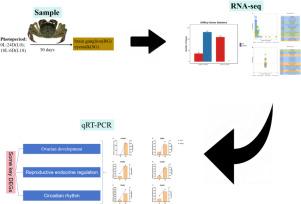Neuroendocrine transcriptomics in Eriocheir sinensis: Photoperiod-induced modulation of gonadal development and circadian clock genes in neural tissues
IF 2.2
2区 生物学
Q4 BIOCHEMISTRY & MOLECULAR BIOLOGY
Comparative Biochemistry and Physiology D-Genomics & Proteomics
Pub Date : 2025-09-09
DOI:10.1016/j.cbd.2025.101629
引用次数: 0
Abstract
Photoperiod is a critical environmental cue that orchestrates reproductive physiology and circadian biology in crustaceans, yet the neural gene networks linking photoperiod to ovarian maturation and clock regulation remain largely unknown. To elucidate the molecular mechanisms underlying photoperiod regulation of ovarian development and associated circadian rhythmicity, the eyestalk (SG) and brain ganglion (BG) of female Chinese mitten crab (Eriocheir sinensis) from two photoperiod groups (Light (L): Dark (D) = 0 h: 24 h (L0) and L: D = 18 h: 6 h (L18)) were used for transcriptome analysis. The analysis identified 298 differentially expressed genes (DEGs) in the brain and 109 DEGs in the eyestalk. KEGG enrichment analysis indicated these DEGs were primarily associated with ovarian development and circadian rhythm-related signaling pathways. Key ovarian development-related genes, including E3 ubiquitin-protein ligase lubel-like isoform X6, 5-hydroxytryptamine receptor-like, serine/threonine-protein phosphatase alpha-2, estrogen sulfotransferase, cytochrome P450 2 L1-like, follicle-stimulating hormone receptor-like isoform X1 and E3 ubiquitin-protein ligase CHIP (EULCHIP), exhibited significant upregulation or downregulation in the L18-BG group. Meanwhile, genes such as EULCHIP, E3 ubiquitin-protein ligase TRIM71-like, CREB-binding protein-like isoform X2, serine/threonine-protein phosphatase 6 regulatory ankyrin repeat subunit C, collagen alpha-5(IV) chain, integrin beta 1, ecdysone-induced protein 74EF-like, and insulin-like growth factor-binding protein complex acid labile subunit showed significant upregulation or downregulation in the L18-SG group. These findings suggest that prolonged photoperiods enhance ovarian development and modulate reproductive endocrine activity during ovarian maturation. Furthermore, circadian rhythm-related genes such as period circadian protein-like isoform X1, prostaglandin D synthase, and acetylcholine receptor subunit alpha-type acr-16 displayed marked differential expression between photoperiod groups, indicating disrupted molecular oscillations and gradual desynchronization of circadian rhythmicity under extended light exposure. This study provides critical, systems-level insights into the photoperiod-driven regulatory networks of ovarian development and endocrine dynamics in crustaceans, offering a molecular basis for optimizing aquaculture practices and advancing our understanding of crustacean reproductive physiology.

中华绒螯蟹的神经内分泌转录组学:神经组织中性腺发育和生物钟基因的光周期诱导调节
光周期是协调甲壳类动物生殖生理和昼夜节律生物学的关键环境线索,但将光周期与卵巢成熟和生物钟调节联系起来的神经基因网络在很大程度上仍然未知。为了阐明光周期调控卵巢发育及其昼夜节律的分子机制,对中华绒螯蟹(Eriocheir sinensis)雌性绒螯蟹(Eriocheir sinensis)的眼柄(SG)和脑神经节(BG)进行了转录组分析,分析了两个光周期组(Light (L): Dark (D) = 0 h: 24 h (L0)和L: D = 18 h: 6 h (L18))的眼柄(SG)和脑神经节(BG)。该分析在大脑中鉴定出298个差异表达基因(DEGs),在眼柄中鉴定出109个差异表达基因(DEGs)。KEGG富集分析表明,这些deg主要与卵巢发育和昼夜节律相关的信号通路有关。卵巢发育相关的关键基因,包括E3泛素蛋白连接酶lubel样异构体X6、5-羟色胺受体样异构体、丝氨酸/苏氨酸蛋白磷酸酶α -2、雌激素硫转移酶、细胞色素P450 2 l1样、促卵泡激素受体样异构体X1和E3泛素蛋白连接酶CHIP (EULCHIP),在L18-BG组均出现显著上调或下调。同时,EULCHIP、E3泛素蛋白连接酶trim71样、creb结合蛋白样异构体X2、丝氨酸/苏氨酸蛋白磷酸酶6调节锚蛋白重复亚基C、胶原α -5(IV)链、整合素β 1、外皮激素诱导蛋白74ef样、胰岛素样生长因子结合蛋白复合体酸不稳定亚基等基因在L18-SG组均出现显著上调或下调。这些结果表明,延长光周期可以促进卵巢发育,调节卵巢成熟过程中的生殖内分泌活动。此外,昼夜节律相关基因,如周期昼夜节律蛋白样异构体X1、前列腺素D合成酶和乙酰胆碱受体亚基α型acr-16在光周期组之间表现出明显的差异表达,表明在长时间光照下,分子振荡被破坏,昼夜节律逐渐去同步。该研究为甲壳类动物卵巢发育和内分泌动力学的光周期驱动调控网络提供了关键的系统级见解,为优化水产养殖实践提供了分子基础,并促进了我们对甲壳类动物生殖生理学的理解。
本文章由计算机程序翻译,如有差异,请以英文原文为准。
求助全文
约1分钟内获得全文
求助全文
来源期刊
CiteScore
5.10
自引率
3.30%
发文量
69
审稿时长
33 days
期刊介绍:
Comparative Biochemistry & Physiology (CBP) publishes papers in comparative, environmental and evolutionary physiology.
Part D: Genomics and Proteomics (CBPD), focuses on “omics” approaches to physiology, including comparative and functional genomics, metagenomics, transcriptomics, proteomics, metabolomics, and lipidomics. Most studies employ “omics” and/or system biology to test specific hypotheses about molecular and biochemical mechanisms underlying physiological responses to the environment. We encourage papers that address fundamental questions in comparative physiology and biochemistry rather than studies with a focus that is purely technical, methodological or descriptive in nature.

 求助内容:
求助内容: 应助结果提醒方式:
应助结果提醒方式:


